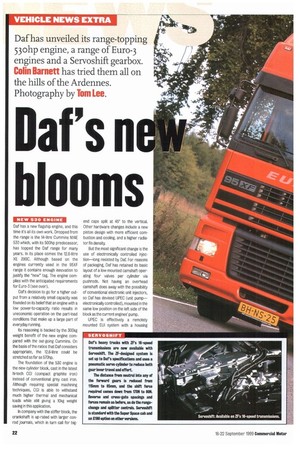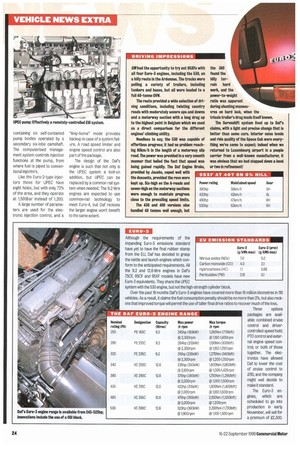ars n
Page 26

Page 28

If you've noticed an error in this article please click here to report it so we can fix it.
loom
NEW 530 ENGINE Daf has a new flagship engine, and this time it's all its own work. Dropped from the range is the 14-litre Cummins N14E 530 which, with its 500hp predecessor, has topped the Daf range for many years. In its place comes the 12.6-litre XE 390C. Although based on the engines currently used in the 95XF range it contains enough innovation to justify the "new" tag. The engine complies with the anticipated requirements for Euro-3 (see over).
Dafs decision to go for a higher output from a relatively small capacity was founded on its belief that an engine with a low power-to-capacity ratio results in uneconomic operation on the part-load conditions that make up a large part of everyday running.
Its reasoning is backed by the 300kg weight benefit of the new engine compared with the out-going Cummins. On the basis of the ratios that Daf considers appropriate, the 12.6-litre could be stretched as far as 570hp.
The foundation of the 530 engine is the new cylinder block, cast in the latest hi-tech CGI (compact graphite iron) instead of conventional grey cast iron. Although requiring special machining techniques, CGI is able to withstand much higher thermal and mechanical loads while still giving a 10kg weight saving in this application.
In company with the stiffer block, the crankshaft is up-rated with larger conrod journals, which in turn call for big end caps split at 45° to the vertical. Other hardware changes include a new piston design with more efficient combustion and cooling, and a higher radiator fin density.
But the most significant change is the use of electronically controlled injection—long resisted by Daf. For reasons of packaging, Daf has retained its basic layout of a low-mounted camshaft operating four valves per cylinder via pushrods. Not having an overhead camshaft does away with the possibility of conventional electronic unit injectors, so Daf has devised UPEC (unit pump— electronically controlled), mounted in the same low position on the left side of the block as the current engines' pump.
UPEC is effectively a remotely mounted EUI system with a housing
containing Six self-contained pump bodies operated by a secondary six-lobe camshaft. The computerised management system controls injection functions at the pump, from where fuel is piped to conventional injectors.
Like the Euro-2-type injectors those for UPEC have eight holes, but with only 72% of the area, and they operate at 1,500bar instead of 1,200.
A large number of parameters are used for the electronic injection control, and a
"limp-home' mode provides backup in case of a system failure. A road speed limiter and engine speed control are also part of the package.
The design of the Oafs engine is such that not only is the UPEC system a bolt-on addition, but UPEC can be replaced by a common rail system when needed. The 9.2-litre engines are expected to use common-re technology to meet Euro-4, but Daf reckons the larger engine won't benefit to the same extent.










































































































